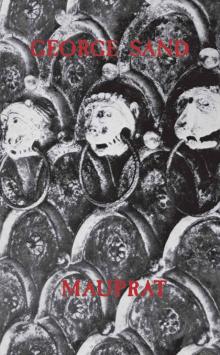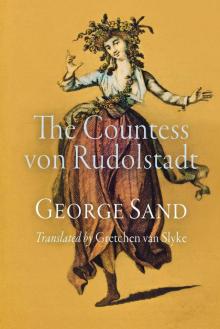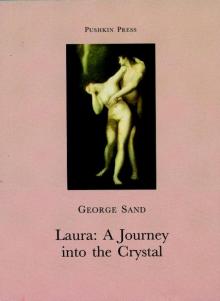- Home
- George Sand
The Countess von Rudolstadt Page 2
The Countess von Rudolstadt Read online
Page 2
Through the religion of Humanity, Leroux hoped not only to remedy the exploitation of the workers and the politically powerless but to put an end to oppression of women as well. Whereas the Revolution of 1789 had refused to grant women the political rights of men, and Napoléon’s Code Civil (1804) kept married women in a permanent state of tutelage under their husbands, Leroux proposed granting women the right to vote in 1851 and argued that marriage could only be based on equality and a mutual sense of responsibility between the spouses. Defining femininity in traditional albeit positive terms, Leroux saw women primarily in their relations to others, as mothers, sisters, partners, and lovers, ready and willing to love, nurture, and sacrifice themselves. Women’s qualities were therefore key to the sense of community, cooperation, and solidarity that Leroux and others sought to develop in society. “Romantic socialists turned this definition of woman’s nature into a source of power and a reason for her exaltation. It was woman’s very relational quality that fit her for the future to which romantic socialists aspired. Woman was seen as less individualized and therefore less self-serving and egoistic than man; she was thus both the appropriate symbol for, and the ideal citizen of, the new social world that they imagined.”9
The version of the biblical creation myth that Leroux presents in De l’Humanité provides insight into his views on the complementarity of the sexes. First of all, Leroux maintains that the creation story in Genesis does not concern an individual named Adam, but a symbol representing all humanity, a reflection of the androgynous nature of God. Likewise, the story about Eve’s creation does not mean that she was drawn out of Adam’s rib. Its proper interpretation signifies instead the separation into two discrete parts of the original androgyne that once contained Adam and Eve together in one body. When Adam and Eve were driven out of the Garden of Eden, psychological division followed upon physical separation. The knowledge that Adam and Eve gained after their fall from grace was disconnection from the androgyne’s other half, isolation within individual identity, and loss of community—in other words, death; and as in Plato’s Symposium, the two halves of the androgyne long for reunion, which in Leroux’s mind will restore humanity’s happiness and bring about a harmonious recognition of women’s rights.
On the eve of her initiation into the Invisibles, Consuelo is stunned to learn that the father-confessor assigned to her is in fact a woman. In this century of patriarchal authority, Consuelo had naturally assumed that men alone would be admitted to this secret society,10 but she learns that a woman not only stands among them but also enjoys membership in the Invisibles’ supreme council, remedying the oversights and failures of discernment on the part of her male fellows and enjoying the prestige of a sibyl and Delphic oracle among the entire group. Indeed, the Invisibles declare themselves to be firm believers in the God-given equality of the sexes, all the while recognizing that the prevailing social and educational condition of women curtails full and immediate application of that precept. As they explain to Consuelo, “we profess the divine equality of men and women. Yet we are forced to recognize that the education of women, their social situation and habits, have had unfortunate results for your sex, to wit, a dangerous flightiness and whimsical instincts; and for this reason we cannot fully put the precept of equality into practice. There are only a few women that we can trust, and some secrets we will impart to you alone.” Consuelo’s father-confessor had initially disguised her sex under a mask, cap, wig, and even a fake beard, the ultimate token of patriarchy, but when she decides to whip them off, she is revealed as a strong and wise mater dolorosa, whom the text compares to both Niobe and the Virgin Mary—a fine example of “intelligence without the beard.”
Sand, who was less critical of women than of the roles that they were made to play in the society of her day, uses this striking expression in a letter to Félicité de Lamennais, a priest of socialist leanings whom she much admired, who had recently rebuked women for their vanity and stupidity, especially those who dared aspire to be like men. Only apparently conceding to his views, she replies in a staunchly progressive tone, “That’s the truth, master: but teach us to be so no longer, and the way to do that is perhaps not by telling us that the fault stems from our nature, but by showing us that it is due to the way that your sex has ruled over us up until now. And if we managed to make God love us as much as he does you men, he might just give us, in spite of you all, intelligence without the beard; and then you in turn would find yourselves in a pretty fix.”11
Not only is Consuelo’s assigned confessor among the Invisibles a woman, she also happens to be the mother of Albert von Rudolstadt, the moribund genius whom Consuelo had reluctantly agreed to marry a few years before. Identifying herself as Wanda z Prachalitz, she is a descendant of Jan Zizka, the indomitable leader of the Taborites in fifteenth-century Bohemia, and carries on their heretical, egalitarian spirit. Despite her position as Consuelo’s mother-in-law, Wanda will renounce the prerogatives generally associated with this role and give highly unorthodox advice to the younger woman, who finds herself in a fierce predicament that needs to be sorted out before her initiation into the Invisibles. Consuelo has just learned that Albert von Rudolstadt is not in fact dead, and meanwhile she has fallen passionately in love with a mysterious stranger among the Invisibles. Must the erstwhile widow return to her husband out of a spirit of duty or trample her wedding vows and follow her heart? Wanda is eager to help Consuelo avoid her own experience of marriage, a loveless match that she contracted for the noblest of reasons, and which finally led to her being buried alive, in all senses of the word. For that reason Wanda asks Consuelo to give the Invisibles, and to her in particular, the right to dissolve or confirm her marriage to Albert. “Extraordinary legislators and secret architects of a new society,” as Wanda calls them, the Invisibles aspire to discern right and true love from false and hollow attachment, to adjudicate between bad human laws and God’s providential designs and to give the world a new ethic.
After making Consuelo confess her physical aversion to Albert as well as her desire for the stranger, Wanda maintains that sexual passions and instincts are given by God and therefore to be heeded. If Consuelo, in these circumstances, were to sacrifice her feelings for the stranger in order to live with her husband, their marriage would be little more than sworn prostitution; she would be committing a monstrous form of suicide, shamefully deceiving her spouse and putting at risk any children conceived of their union. Wanda asserts that the law of marriage is mutual desire and shared aspirations; where there is no such reciprocity, there is no equality; and where there is no equality, there is no real union. Far from requiring that Consuelo sacrifice her love for the stranger, God in fact denies her the right to contemplate such self-immolation. Yet the protection of love requires no divorce, for it is finally revealed that Consuelo’s stranger is none other than Albert himself, come back from the grave like his mother. In any event, Wanda’s notion of marriage was clearly revolutionary in Consuelo’s century, and in Sand’s century as well, where dowries continued to preside over nuptials and daughters were passed willy-nilly from the authority of their fathers to that of their husbands.
Sand knew firsthand the public and private hardships of nineteenth-century marriage. While immersed in the composition of Consuelo and La Comtesse de Rudolstadt, Sand received a letter from Mlle Leroyer de Chantepie, an unmarried forty-something writer from provincial France, asking her advice about the wisdom of seeking love and happiness in marriage. Approaching the age of forty herself and having meditated at length upon the situation of women in a society where marriage or a nun’s celibacy were nearly their only respectable options, Sand replied that despite her convictions that love, fidelity, and motherhood were the “most necessary, important and sacred acts in a woman’s life,” no woman should enter into the contract of marriage as it was then defined by Napoléon’s Code Civil:
I find society given over to the most dreadful chaos, and, amidst all the iniquities that I see consecrated
by society, I consider, first and foremost, that the relations of men with women have been established in a manner that is unjust and absurd. I cannot therefore advise anyone to undertake a marriage sanctioned by a civil code that consecrates the woman’s dependence, inferiority and social nullity. I’ve spent ten years thinking about it, and, after having wondered why all the loves in this world, whether they be legitimated or not by society, were all more or less unhappy, no matter the qualities and virtues of the souls so associated, I’ve become convinced of the radical impossibility of this perfect happiness, love’s ideal, in conditions of inequality, inferiority and dependence of one sex with regard to the other. . . . A woman, giving herself to a man, is necessarily either chained or guilty.12
Judging that a total transformation of the world was necessary, but recognizing that radical change could not happen overnight, Sand did not renounce her hopes for women’s happiness but deferred them to the brighter future set forth by Pierre Leroux, one that she felt sure to enjoy in a later life. In the meantime, what were women to do? Sand felt that they had no choice but to go on with life, even love and motherhood, doing their duty to the best of their abilities, bearing in mind the inevitability of suffering and humiliation in the here and now and consoling themselves with the thought of women’s happiness in some time to come. And the path that she recommended to Mlle Leroyer de Chantepie is the one that the author herself had taken some years before, as she forcefully recounts to the painter Eugène Delacroix in August 1843: “In short, I no longer exist, as I’ve told you. A good three years ago I died, having willfully committed suicide to prevent myself from dying and prolonging the ridiculous throes of death. My ideal is no longer in my life here and now. It is in another world, another century, in another humanity, where I am sure to wake up after the salutary repose of death.”13
Given the condition of women in nineteenth-century French society—provided with few and limited educational opportunities, lacking most civil rights and all political rights, subjected to the rule of their husbands in their lives and any property they might possess—Sand considered all women heretics, at least potentially, and was proud to add them to the long list of purveyors of the secret doctrine that she hailed as a promise of revolution throughout the ages. This is surely one of the main reasons why in the course of Consuelo and La Comtesse de Rudolstadt she frequently addresses her readers with the exclusively feminine form lectrices. In the previously cited companion piece that she wrote about the Hussite leader Jan Zizka, Sand further explains her concentration upon her female readers:
Women, when I remember that it’s for you that I’m writing, I feel my heart more at ease; for I have never doubted that, despite your vices and failings, your notable laziness, your absurd coquetry and childish frivolity, there is in you something pure, enthusiastic, candid, great and generous, which men have lost or do not yet possess. You are beautiful children. Feeble heads, wretched educations, next to no forethought, empty memories, inert reasoning ability. It’s not your fault! While your minds have remained idle, God has allowed your hearts to develop more freely than those of men and let you keep the sacred fire of love, the treasures of devotion, the tender charms of romantic insouciance and blind unselfishness. This is why, poor women, noble beings, whom it has not been within man’s power to degrade, this is why the history of heresy must be of interest to you and touch you in a particular way; for you are the daughters of heresy, you are all heretics; you all protest in your hearts, you all protest in vain. Like the voice of the protestant Church of every century, your voice is stifled by the decree of the official Church of society. You are all by nature and necessity the disciples of Saint John, of Saint Francis, of the other great apostles of the ideal. You are all poor in the manner of the eternal disciples of evangelical poverty; for, according to the laws of marriage and the family, you own nothing; and it’s to this absence of power and action in temporal interests that you owe this idealist tendency, this power of sentiment, these impulses of abnegation that make your souls the last sanctuary of truth, the last altars for sacrifice.14
If women have half-baked or unformed minds, Sand will attempt to reach them through their hearts and souls, seeing sentiment as an effective way into their intellect. This, moreover, is the way through which Consuelo’s religious and political development is achieved in Consuelo and La Comtesse de Rudolstadt, and Sand often described her own education as a result of the same method. Thus, the character of Consuelo, modeled in part on Pauline Viardot, mirrors as well what Sand sees as the course of her own development, and the author clearly intends to encourage her readers to let their feelings guide them down similar paths. Writing novels is her own modest contribution toward changing the world, as she explains in a letter toward the end of 1842:
I may spend my entire life searching for the truth, without ever knowing how to formulate a single aspect of it. To each his own task. I do what I can. Born a writer of novels, I write novels—which means that I seek by virtue of a certain art to rouse emotion, to churn and shake things up, even to rattle the hearts of my contemporaries who are capable of emotion and need to be shaken up. Those who aren’t capable of emotion say that I’m stirring up poison because I’m putting a bit of gall in the wine of their insolent drunkenness. . . . But I’ve roused emotion, and emotion prompts thought and investigation. That’s all I wanted. To inspire doubt about the lie that is believed, to raise a hue and cry about a truth that is forgotten—that’s enough for me, and my mission is no greater than that.15
As in The Magic Flute, the initiation in La Comtesse de Rudolstadt is immediately followed by a wedding. Yet these obvious points of comparison between Emanuel Schikaneder’s libretto for The Magic Flute and Sand’s novel mask profound differences. Whereas Tamino’s ordeal in the opera takes place in a context structured upon the dichotomy of masculine versus feminine, good versus evil, La Comtesse de Rudolstadt rejects that view and celebrates instead the reunion of the androgyne, “the soul in two persons” consecrated by the wedding of Consuelo and Albert. At the conclusion of the opera, Tamino is granted the hand of his beloved Pamina as a reward for having withstood the rigors of his ordeal. At the end of La Comtesse de Rudolstadt, Consuelo is no reward for the hero. She is instead a heroine in her own right; having emerged victorious from her ordeals, she reaches a level of spiritual development attained by few men, and she wholeheartedly gives herself to Albert as his wife and partner. Thanks to Wanda’s inspired intervention, the wedding of Consuelo and Albert among the Invisibles becomes an entirely different thing from unions contracted in the world. The bride and groom come together in mutual joy and shared passion, and their marriage is an expression of freely chosen love. Before God and the Invisibles, they vow to remain together throughout eternity, yet their covenant is to remain unwritten and therefore beyond the jurisdiction of any earthly authority, priest or magistrate. Sand’s novel may well be the first woman-centered novel of initiation in European literature, and it is no accident that this revolutionary work was authored by “a highly literate woman, a consummate storyteller, fully cognizant of the novelistic, religious, and philosophical traditions which she was following as well as subverting.”16
Another significant difference between the two works is this: whereas The Magic Flute ends on the blissful note of love triumphant, La Comtesse de Rudolstadt swings back into the stuff of life, with its burdens and disappointments. After her wedding Consuelo continues her singing career all over Europe while she and Albert secretly devote themselves to pursuing the work of the Invisibles. In Vienna around 1760, Consuelo loses her voice and disappears from the stage. At the same time, Albert is thrown into prison, endures a long, hopeless trial, and is finally expelled from Austria as a dangerous madman. After the Invisibles are finally dispersed and their organization destroyed, the couple enter upon a life of poverty, suffering, and persecution, and Albert’s mind becomes unhinged. Despite all this, they do not lose their faith, and their love keeps its bright promise. Yet, wi
th information about them becoming ever more fragmentary and unreliable, their story has no ending. Rather, the narrator refuses to provide one, invoking instead an E. T. A. Hoffmann novel with many different imagined endings, like a beautiful river branching out in the sands of a delta and vanishing into a thousand whimsical rivulets. The best of endings, this narrator maintains, are those that the readers undertake for themselves, in the narrator’s stead.
The last glimpse of Consuelo and Albert in the novel is offered by a young disciple of the Bavarian Illuminati who, along with the sect’s founder, has gone searching for Albert in the hopes of learning more about the new society that the Invisibles had been devising for the world. They come upon Consuelo, her husband, and three of their children wandering through the mountains of Bohemia, praying with the peasants and making music around the ruins of Albert’s ancestral home. Albert is now insane and tenderly looked after by his wife and children, for they recognize that madness, treated with the proper respect and care, is “an exceptional faculty of the most poetically divine sort.” By playing ancient folk ballads and sacred hymns of the Hussites for the Bohemian peasants, Albert imparts to them visions of the past and prophecies for the future, God’s providential designs for humanity. For him, time and death are mere illusions, and the distinctions among past, present, and future vain niceties; God is eternal and so are those who partake of his essence. Assuming the mythic dimensions of Orpheus, Albert finally sends the Bavarian Illuminati off to France, which he predicts will soon become the present-day Tabor once so dear to the Hussites, the new light of the nations with the advent of the Revolution.

 Lelia
Lelia Mauprat
Mauprat Valentine
Valentine The Countess von Rudolstadt
The Countess von Rudolstadt Laura
Laura Indiana (Oxford World's Classics)
Indiana (Oxford World's Classics)